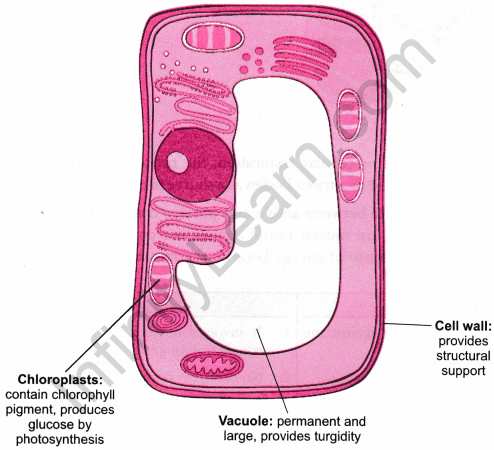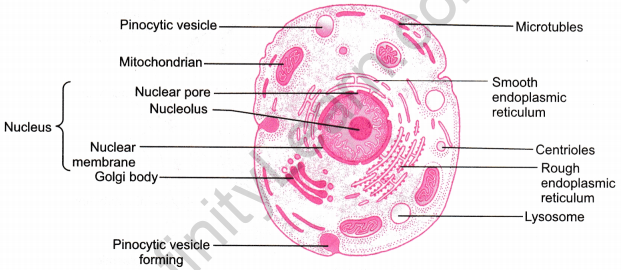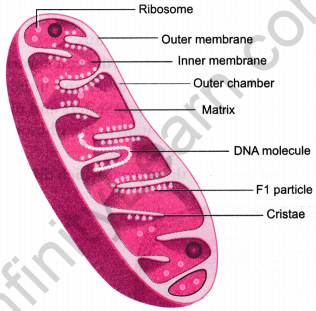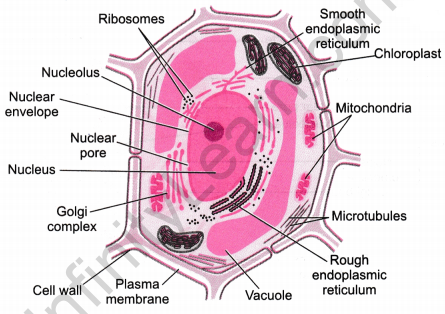Table of Contents
The Fundamental Unit of Life Class 9 Extra Questions Science Chapter 5
Extra Questions for Class 9 Science Chapter 5 The Fundamental Unit of Life
The Fundamental Unit of Life Class 9 Extra Questions Very Short Answer Questions
Question 1.
Plasma membrane is made up of which two components?
Answer:
Plasma membrane is made up of lipids and proteins.
Question 2.
What is hypotonic solution?
Answer:
A solution having solute concentration lower than that of the cell sap is called hypotonic solution.
Question 3.
What is hypertonic solution?
Answer:
A solution having solute concentration higher than that of the cell sap is called hypertonic solution.
Question 4.
What is isotonic solution?
Answer:
A solution having solute concentration same as that of the cell sap is called isotonic solution.
Question 5.
Cell wall is made up of which component?
Answer:
Cell wall is made up of cellulose.
Question 6.
Give an example of unicellular organism.
Answer:
Amoeba, Bacteria, Paramecium. (Any one)
Question 7.
Give an example of multicellular organism.
Answer:
Fungi, plants, animals. (Any one)
Question 8.
What is active transport?
Answer:
The movement of molecules across a membrane in cells against a concentration gradient with the help of ATP units is called active transport.
Question 9.
What is the intracellular source of digestive enzyme?
Answer:
Lysosome
Question 10.
What is endocytosis?
Answer:
Endocytosis is the ingestion or engulfment of food and other material by folding of the plasma membrane it as seen in Amoeba.
Question 11.
Where are genes located?
Answer:
Genes are located on chromosomes in the nucleus.
Question 12.
Name two structures found in plant cells but not in animal cells.
Answer:
Cell wall and chloroplast
Question 13.
Name two structures found in animal cells but not in plant cells.
Answer:
Lysosomes and centrioles
Question 14.
Which organelle is involved in the formation of lysosomes?
Answer:
Golgi apparatus
Question 15.
What is the outermost layer found in animal cells?
Answer:
Plasma membrane
Question 16.
What is the outermost layer found in the plant cell?
Answer:
Cell wall
Question 17.
Which organelle is the storage sac of solid and liquid materials?
Answer:
Vacuoles
Question 18.
Which organelle serves as a channel for transport of materials between cytoplasm and nucleus?
Answer:
Endoplasmic reticulum
Question 19.
What is microscope?
Answer:
Microscope is an optical instrument consisting of a lens or combination of lenses which renders minute objects distinctly visible.
Question 20.
Why is light microscope called a compound microscope?
Answer:
Light microscope is called a compound microscope because it consists of two or more lens systems.
Question 21.
Which organelle is associated with ribosome formation?
Answer:
Nucleolus
Question 22.
What are chromosomes made up of?
Answer:
Chromosomes are made up of DNA and protein.
Question 23.
Define plasmolysis.
Answer:
It is the shrinkage of cytoplasm due to loss of water when kept in a hypertonic medium.
Question 24.
What is a nucleoid?
Answer:
The undefined nuclear region in the cytoplasm of prokaryotes is known as nucleoid.
Question 25.
Which organelles other than nucleus contain DNA?
Answer:
Mitochondria and plasmids contain DNA.
Question 26.
Name the only cell organelle seen in prokaryotic cell.
Answer:
Ribosomes
Question 27.
Which microorganisms can be made into crystal?
Answer:
Viruses
Question 28.
Which organelle detoxify many poisons and drugs in a cell?
Answer:
Peroxisome
Question 29.
Name a cell organelle which is non-membranous. [NCERT Exemplar]
Answer:
Ribosome.
Question 30.
Define diffusion.
Answer:
Movement of molecules from a region of higher concentration to a region of lower concentration is called diffusion.
Question 31.
Why is endocytosis found in animals only? [NCERT Exemplar]
Answer:
For endocytosis to occur, the outermost membrane should be flexible like the plasma membrane of animals. But in plant cells, cell wall is the outermost membrane which is very rigid. Hence, endocytosis occurs only in animals and not in plants.
Question 32.
Which cell organelle controls most of the activities of the cell? [NCERT Exemplar]
Answer:
Nucleus, also known as the brain of the cell, controls most of the activities of the cell because it contains DNA (Deoxyribonucleic acid) which contains all the information of the cell.
The Fundamental Unit of Life Class 9 Extra Questions Short Answer Questions—I
Question 1.
Describe the microscopic structure of the cell.
Answer:
The cork cells were the first cells to be observed. They were composed of box-like compartments, forming a honeycomb structure. Cell organelles are found embedded in the cytoplasm.These are smaller in size and bounded by plasma membrane.
Question 2.
How can you calculate the magnification of a microscope?
Answer:
Magnification of a microscope is calculated by multiplying the powers of eyepiece and objective lenses.
Mathematically, M = P1 × P2, where Pi is the power of eyepiece andP2 is the power of objective.
Question 3.
What is a cell wall and how is it formed?
Answer:
Cell wall is non-living and freely permeable rigid structure bounding the plant cell. It is secreted by the cell itself for the protection of its plasma membrane and cytoplasm.
Question 4.
Why were the scientists not able to observe most of the cell organelles before 1940?
Answer:
Before 1940, scientists could view the cell only under a light microscope. The invention of the electron microscope in 1940 enabled the scientists to observe the cell in greater detail.
Question 5.
There would be no plant life if chloroplasts did not exist. Justify.
Answer:
Chloroplasts contain the pigment chlorophyll which is responsible for food preparation in plants by the process of photosynthesis . Hence, if there were no chloroplasts then there would not have been any plant life.
Question 6.
Why is the Golgi apparatus called the secretary organelle of the cell?
Answer:
This is because it packages material synthesised in the ER and dispatches it to intracellular (plasma membrane and lysosomes) and extracellular (cell surface) targets.
Question 7.
What are the functional regions of a cell?
Answer:
There are three major functional regions of cells:
- cell membrane or plasma membrane,
- nucleus and
- cytoplasm.
Question 8.
What is cell sap? Give its composition.
Answer:
Liquid content in the vacuoles of plant cell is called cell sap. The cell sap contains sugars, amino acid, proteins, minerals and metabolic wastes.
Question 9.
What is cytosol and cytoskeleton?
Answer:
Cytosol fs the semifluid part of the cell cytoplasm which is embedded in between cell organelles. Cytoskeleton is a network of protein fibres present in the cell which provides a supporting framework for the organelles.
Question 10.
What are secretory proteins? Give an example of secretory protein.
Answer:
Proteins which are synthesised by the cell and then released into outer medium of the cell are called secretory proteins. Examples of secretory proteins include mucus, digestive enzymes and hormones.
Question 11.
Why are peroxisomes mostly found in kidney and liver cells?
Answer:
Peroxisomes contain various oxidative enzymes which detoxify the toxic material. Since the blood carries various toxic substances to kidney and liver, a large number of peroxisomes are present in them to oxidise the toxic material.
Question 12.
What do you mean by plasmodesmata?
Answer:
Due to the presence of cell wall the exchange of materials between the plap.t cells is not possible. Therefore, protoplasts of plant cells are connected by cytoplasmic channels through their walls which are called as plasmodesmata. These channels are used for the exchange of the material between two cells.
Question 13.
Why do the animal cells not have cell wall?
Answer:
Animals do not have rigid walls because cell walls are incompatible with the way in which an animal moves and grow. The flaccid cell membrane provides the animal cell freedom of mobility and formation of different tissues which is not present in plants.
Question 14.
Why are the Golgi bodies found in large numbers in the cells which secrete digestive enzymes?
Answer:
The main function of Golgi bodies is to release proteins or enzymes by vesicles. No other organelle has this property. Therefore, these are largely present in secreting cells.
Question 15.
What is the significance of pores present on the nuclear membrane?
Answer:
The pores present on the nuclear membrane allow transport of water-soluble molecules across the nuclear envelope. RNA and ribosomes move out of the nucleus, whereas carbohydrates, lipids and proteins move into the nucleus.
Question 16.
What are asters and spindle fibres?
Answer:
Asters are two star-like structures radiating fibres from the centrosome. They help in locating spindle and trigger cleavage of cytoplasm.
Spindle fibres are formed from microtubules during cell division. They pull the chromosomes apart and bring them at the poles. These are broader in the middle and narrower at the poles.
Question 17.
Do you agree “A cell is a building unit of an organism”. If yes, explain why. [NCERT Exemplar]
Answer:
An organism is made up of various organ systems like digestive system, nervous system, etc. These organ systems in turn are made up of various organs which are made up of tissues. Also tissues are a group of cells performing the same function. Hence, a cell is the building unit of an organism. Cell → tissue → organ → organ system → organism
Question 18.
If you are provided with some vegetables to cook, you generally add salt into the vegetables. After adding salt, vegetables release water. Why? [NCERTExemplar]
Answer:
When salt is added, a hypotonic medium is created, i.e., the concentration of salt molecules is more outside the vegetables than inside. Hence, due to osmosis water from the vegetables come out.
Question 19.
How are chromatin, chromatid and chromosomes related to each other? [NCERTExemplar]
Answer:
Chromatin is a thin thread-like structure which is composed of DNA (deoxy ribonucleic acid) and proteins to form a rod-like chromatid. Two similar chromatids attach to a centromere to form a chromosome.
Question 20.
How is bacterial cell different from onion peel? [NCERT Exemplar]
Answer:
| Bacterial cell | Onion peel |
| 1. Size is small (1-10 mm).
2. Nucleus is absent. 3. It is a prokaryotic cell. 4. Cell division takes place by fission or budding. |
1. Size is larger (5-100 mm).
2. Nucleus is present. 3. It is a eukaryotic cell. 4. Cell division takes place by mitosis. |
The Fundamental Unit of Life Class 9 Extra Questions Short Answer Questions-II
Question 1.
Differentiate between diffusion and osmosis.
Answer:
| Diffusion | Osmosis |
| 1. It occurs in any medium.
2. Diffusing molecules may be solid, liquid or gaseous solutes. 3. Semipermeable membrane is not required. |
1. It occurs in liquid medium only.
2. It involves movement of solvent molecules only. 3. Semipermeable membrane is required. |
Question 2.
Differentiate between rough and smooth endoplasmic reticulum. How is endoplasmic reticulum important for membrane biogenesis ? [NCERT Exemplar]
Answer:
| Rough endoplasmic reticulum | Smooth endoplasmic reticulum |
| 1. They have ribosomes attached on their surfaces.
2. RER manufactures proteins and transports them to various places. |
1. They do not have ribosomes attached on their surfaces.
2. SER helps in manufacturing lipids and transports them to various places. |
Endoplasmic reticulum act as main site for synthesis of protein and lipids which are needed for the biogenesis of plasma membrane.
Question 3.
What is membrane biogenesis? How is plasma membrane formed during this process?
Answer:
The process of plasma membrane formation is called membrane biogenesis.
Following organelles are involved in this process:

The proteins and lipids are first synthesised in rough endoplasmic reticulum and the smooth endoplasmic reticulum, respectively. These are then transported to the Golgi complex for their modification. After modification, these are transported to the cell surface through vesicles which bud off from Golgi complex to fuse with cell membrane and form a part of the membrane.
Question 4.
Write the name of different plant parts in which chromoplast, chloroplast and leucoplast are present. [NCERT Exemplar]
Answer:
Chromoplasts are present in flowers, fruits or any other coloured part of the plant (other than green part).
Chloroplasts are present in leaves and stem of plant (green part).
Leucoplasts are present anywhere in plant as they are colourless and store food.
Question 5.
What is cell division? Give the types of cell division.
Answer:
Cell division is a process of formation of two or more daughter cells of its own type from the mother cell. These are similar in structure and function.
Cell division occurs in three ways:
- Amitosis
- Mitosis
- Meiosis
In each case, division of nucleus (Karyokinesis) occurs before the division of cytoplasm (Cytokinesis).
Question 6.
What are the functional differences between a plasma membrane and cell wall?
Answer:
| Plasma membrane | Cell wall | |
| 1. It holds cellular contents and controls passage of materials in and out of cell. | 1. It gives protection, strength and rigidity to the cell. | |
| 2. It is semipermeable in nature and allows entry of selected molecules into the cell. | 2. It is completely permeable in nature. | |
| 3. It is not elastic. | 3. It is elastic and controls the cell’s turgidity preventing its bursting. | |
Question 7.
What are the functions of nuclear membrane?
Answer:
- A nuclear envelope separates the environment of nucleus from that of rest of the cell.
- It protects the genetic material from damage.
- It facilitates and regulates exchange of materials in and out of the nucleus.
Question 8.
Write a note on Golgi apparatus and the functions it performs.
Answer:
Golgi apparatus or Golgi bodies or Golgi complex is composed of membrane-bound fluid-filled vesicles, vacuoles and cisternae. In animal cells they are larger and only one or two in number, while in plants they are smaller and more in number. Also, in plant cells, they are distributed throughout – the cytoplasm and are called dictyosomes.
Functions:
- It is involved in the transport and modification of protein, lipids as well as carbohydrates.
- It helps in the formation of cell plate during cell division.
- It is also involved in the formation of cell wall, plasma membrane lysosomes and peroxisomes.
- The material synthesised near endoplasmic reticulum is packaged and dispatched to various targets and outside the cell through the Golgi apparatus.
Question 9.
How will absence of any one of the cell organelle affect the cell’s working?
Answer:
Functions of all the organelles are inter-linked to each other and ultimately to the working of the cell. So, if even a single link is missing, the cell ultimately suffers and die. For example, DNA from the nucleus passes the information for protein formation to the ribosomes which send the proteins to Golgi complex and ER for modification and transport.
Question 10.
Draw a neat diagram of plant cell and label any three parts which differentiate it from animal cell.
Answer:

Question 11.
Draw a neat labelled diagram of an animal cell. [NCERT Exemplar]
Answer:

The Fundamental Unit of Life Class 9 Extra Questions Long Answer Questions
Question 1.
Draw a labelled diagram of mitochondria. Write the functions of mitochondria.
Answer:

Functions of mitochondria:
The mitochondria are the main sites for cellular respiration, the process in which the cell converts sugars and oxygen into ATP. ATP is used by various bodies as a source of energy to perform functions.
Question 2.
What is active transport? Differentiate between active and passive transport.
Answer:
The process in which the molecules are moved uphill against the concentration gradient. Active transport always involves the expenditure of energy because the materials are pumped against the concentration gradient.
| Active transport | Passive transport |
| 1. It involves movement of molecules against the concentration gradient.
2. It requires energy in the form of ATP molecules. 3. It is a rapid movement. 4. Movement of large molecules occur by active transport. |
1. It involves movement of molecules along the concentration gradient.
2. No energy is required. 3. It is a slow movement. 4. Only small molecules or water molecules are transported passively. |
Question 3.
Illustrate only a plant cell as seen under electron microscope. How is it different from animal cell? [NCERT Exemplar]
Answer:

Major diferences are:
- Plant cells have chloroplasts
- Plant cells have large vacuoles.
- Plant cells have cell walls.
Question 4.
In brief state what happens when:
(a) dry apricots are left for sometime in pure water and later transferred to sugar solution?
(b) a red blood cell is kept in concentrated saline solution?
(c) the plasma membrane of a cell breaks down?
(d) rheo leaves are boiled in water first and then a drop of sugar syrup is put on it?
(e) golgi apparatus is removed from the cell? [NCERT Exemplar]
Answer:
(a) The apricots swell due to osmosis initially and when transferred to sugar solution shrink again due to exosmosis.
(b) RBCs shrink due to exosmosis.
(c) It would lead to scattering of cell organelles and there will be no functioning of the organs.
(d) There will be no change in cell shape or size because the cells are dead due to boiling.
(e) Function of Golgi apparatus is packing, storing and transfer of protein. It would affect the functioning of cell.
The Fundamental Unit of Life Class 9 Extra Questions HOTS (Higher Order Thinking Skills)
Question 1.
If cells of onion peel and RBC are separately kept in hypotonic solution, what will happen to each of them? Explain the reason for your answer.
(a) Both the cells will swell.
(b) RBC will burst easily while cells of onion peel will resist the bursting to some extent.
(c) (a) and (b) both are correct.
(d) RBC and onion peel cells will behave similarly. [NCERT Exemplar]
Answer:
(b). When kept in a hypotonic solution, the onion cells will become turgid because the water will
enter the cell due to osmosis. But the cell wall present outside the cell provides it rigidity and does not let any harm to occur.
Whereas, in RBC the movement of water inside the cell due to osmosis will lead to bursting of the cell because it does not have a rigid cell wall.
Therefore RBC will burst easily while onion cell peels will resist it to some extent.
Question 2.
A person takes concentrated solution of salt, after sometime, he starts vomiting. What is the phenomenon responsible for such situation? Explain. [NCERT Exemplar]
Answer:
Concentrated salt solution is a hypertonic solution. This causes exosmosis in the cells of the alimentary tract. This further results into dehydration and irritation thus resulting in vomiting.
Question 3.
Where will you find more number of ribosomes-in cancer cells or in fat cells?
Answer:
Ribosomes are found in greater number in actively dividing cells which are the cancer cells as they need more amount of proteins for the formation of new cells.
Question 4.
A solution of 3% glucose and a solution of 8% glucose are kept in a trough separated by a semipermeable membrane. What will you observe after 1 hour?
Answer:
After 1 hour the solutions on both the sides of the semipermeable membrane will become isotonic because of the process of osmosis.
Question 5.
What are the colours absorbed by plants? The green light of the sunlight is blocked. How will the photosynthesis be affected?
Answer:
Plants absorb all the colours in the spectrum. The plants reflect back the green light because of which they appear green in colour. Therefore, photosynthesis will not be affected if green light is blocked.
Question 6.
Why does the skin of your finger shrink when you wash clothes for a long time? [NCERT Exemplar]
Answer:
Soap solution is a hypertonic solution. When our fingers are in contact with it for a long time, water from epidermal cells of fingers diffuse out through the process of osmosis and the skin shrinks.
More Topics Related to Class 9
| NCERT Solutions for Class 9 | NCERT Books for Class 9 |
| Extra Questions for Class 9 Maths with Solutions | NCERT Solutions for Class 9 Science |









